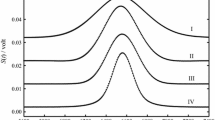Abstract
Nernst—Planck equations and ionic conductivities are used to calculate accurate limiting interdiffusion coefficients D oik for mixed electrolyte solutions. The electrostatic mechanism for coupled electrolyte diffusion is investigated by calculating the electrostatic contribution to each D oik coefficient to give the flux of each electrolyte driven by the electric field, which is generated by the migration of ions of different mobilities. Ternary diffusion coefficients are measured for dilute aqueous K2SO4 + KOH and Li2SO4 + LiOH solutions. Because of the different mobilities of K+ and Li+ ions relative to SO 2−4 ions, diffusing K2SO4 drives cocurrent flows of KOH, but diffusing Li2SO4 drives counterflows of LiOH. To describe coupled diffusion in concentrated mixed electrolyte solutions, the Hartley–Crank theory is used to correct the limiting D oik coefficients for nonideal solution behavior, viscosity changes, ionic hydration, and the zero-volume flow constraint. Diffusion coefficients predicted for concentrated aqueous CaCl2 + HCl solutions are compared with recently reported data. The large amount of HCl cotransported by the diffusing CaCl2 is attributed to the “salting out” of HCl by CaCl2 and to the migration of H+ ions in the diffusion-induced electric field, which slows down the Cl− ions and speeds up the less-mobile Ca2+ ions to maintain electroneutrality along the CaCl2 gradient.
Similar content being viewed by others
REFERENCES
H. J. V. Tyrrell and K. R. Harris, Diffusion in Liquids (Butterworths, London, 1984).
E. L. Cussler, Multicomponent Diffusion (Elsevier, Amsterdam, 1976).
D. G. Miller, A. W. Ting, and J. A. Rard, J. Electrochem. Soc. 135, 896 (1988).
J. A. Rard and D. G. Miller, J. Phys. Chem. 91, 4614 (1987).
H. Kim, G. Reinfelds, and L. J. Gosting, J. Phys. Chem. 77, 934 (1973).
R. P. Wendt, J. Phys. Chem. 66, 1279 (1962).
V. Vitagliano, R. Laurentino, and L. Costantino, J. Phys. Chem. 73, 2456 (1969).
D. G. Leaist, J. Chem. Soc. Faraday Trans. 89, 2775 (1993).
R. A. Robinson and R. H. Stokes, Electrolyte Solutions, 2nd edn., (Academic Press, New York, 1959), Chap 11.
J. S. Newman, Electrochemical Systems (Prentice Hall, Englewood Cliffs, 1973).
V. Vitagliano and R. Sartorio, J. Phys. Chem. 74, 2949 (1970).
G. S. Hartley and J. Crank, Trans. Faraday Soc. 45, 801 (1949).
J. R. Hall, B. F. Wishaw, and R. H. Stokes, J. Am. Chem. Soc. 75, 1556 (1953).
B. F. Wishaw and R. H. Stokes, J. Am. Chem. Soc. 76, 2065 (1954).
B. R. Hammond and R. H. Stokes, Trans. Faraday Soc. 52, 781 (1956).
R. Mills, J. Phys. Chem. 67, 600 (1963).
K. S. Pitzer, J. Am. Chem. Soc. 96, 5701 (1974).
K. S. Pitzer, J. Phys. Chem. 77, 268 (1973).
K. S. Pitzer and G. Mayorga, J. Phys. Chem. 77, 2300 (1973).
K. S. Pitzer and G. Mayorga, J. Solution Chem. 3, 539 (1974).
J. Schmoll and H. G. Hertz, Z. Phys. Chem. 194, 193 (1996).
C. Erkey and A. Akgerman, in Measurement of the Transport Properties of Fluids, W. A. Wakeham, A. Nagashima, and J. V. Sengers, eds. (Blackwell, Oxford, 1991).
D. G. Leaist, J. Chem. Soc. Faraday Trans. 87, 597 (1991).
Z. Deng and D. G. Leaist, Can. J. Chem. 69, 1548 (1991).
J. A. Rard and D. G. Miller, J. Solution Chem. 8, 701 (1979).
P. Rizzo, J. G. Albright, and D. G. Miller, J. Chem. Eng. Data 42, 623 (1997).
J. W. Mullin and A. W. Nienow, J. Chem. Eng. Data 9, 526 (1964).
D. G. Leaist and L. Hao, J. Solution Chem. 21, 345 (1992).
R. A. Noulty and D. G. Leaist, J. Solution. Chem. 13, 767 (1984).
D. G. Leaist and P. A. Lyons, J. Phys. Chem. 86, 564 (1982).
D. G. Leaist, J. Chem. Soc. Faraday Trans. I 78, 3069 (1982).
D. G. Leaist and R. A. Noulty, Can. J. Chem. 63, 476 (1985).
D. G. Leaist, L. Hao, and R. Abragimov, J. Chem. Soc. Faraday Trans 89, 515 (1993).
D. G. Leaist, J. Phys. Chem. 93, 474 (1989).
P. J. Dunlop and L. J. Gosting, J. Phys. Chem. 63, 86 (1959).
P. A. Lyons and J. F. Riley, J. Am. Chem. Soc. 74, 5216 (1954).
P. C. Carman, J. Phys. Chem. 73, 1095 (1969).
I. D. Zaytsev and G. G. Aseyev, Properties of Aqueous Solutions of Electrolytes (CRC Press, Boca Raton, 1992), pp. 176, 206.
J. A. Harpst, E. Holt, and P. A. Lyons, J. Phys. Chem. 69, 2333 (1965).
Rights and permissions
About this article
Cite this article
Leaist, D.G., Curtis, N. Hartley–Crank Equations for Coupled Diffusion in Concentrated Mixed Electrolyte Solutions. The CaCl2 + HCl + H2O System. Journal of Solution Chemistry 28, 341–366 (1999). https://doi.org/10.1023/A:1022603827760
Issue Date:
DOI: https://doi.org/10.1023/A:1022603827760



